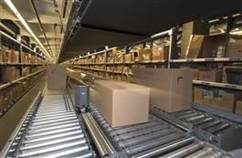|
Holste Says:
|
 One
example of how sortation
is now being deployed
to increase split case
picking throughput performance
and productivity can be
found in the pick and
pass environment. One
example of how sortation
is now being deployed
to increase split case
picking throughput performance
and productivity can be
found in the pick and
pass environment.

|
The first full case batch order picking and sorting systems were put into service in the early 1970’s. Over the years, batch order picking and sorting has proven its ability to increase throughput while decreasing labor when compared to non-automated discrete order picking methods. However, it’s only been in recent years that sorting technology has provided some relief for split case picking operations.
“Split case picking” is one of several terms used to describe the picking of individual items, rather than full cases (sometimes also called “eaches picking," loose case, etc.). Typically, items are picked directly into a shipping carton, or else into a plastic tote that is later packed into the final shipping carton (sometimes in closed-loop systems the totes themselves are the shipping container.)
Split case picking is often the bane of distribution managers. It can be very expensive and slow. Except for very high end equipment used in specialty applications (pharmaceuticals, CDs, etc.), it can’t really be well automated.
But use of sortation systems certainly can provide relief in many circumstances. One example of how sortation is now being deployed to increase split case picking throughput performance and productivity can be found in the pick and pass environment.
Pick and Pass Options
Without going into too much system design/operational detail, let’s first look at a typical non-automated pick and pass system configuration. In this example, a powered takeaway conveyor line is centered between two banks of case flow racks. A dead roller conveyor is located along both sides of the powered conveyor line leaving enough aisle space for picking between the face of the flow rack and the edge of the roller conveyor. All picking must begin in the first zone. A preprinted pick list is attached to an empty container (tote box or shipping carton), and the container is placed on the roller conveyor. The picker working that zone pushes the container (sometimes 2 or 3 at a time) thru the zone, picking the required product (for each container) along the way. The picker is required to check off each product picked.
At the end of the zone, the container is either complete (no more items required) or it requires items from downstream zones. If the container is complete, it is pushed onto the powered takeaway line where it is transported to order checking, packing, and shipping. If more items are required, the container is passed onto the next downstream zone and the picking routine is repeated. The container is passed through each consecutive zone until all items on the order have been picked. All orders start in the first zone even if no picks are required in that zone. If the order requires a pick in the first and last zones, it must be pushed thru all of the in-between zones.
In the above example, a simple paper pick list was used to drive item picking. RF, Pick-to-Light, or Voice technologies are commonly used to drive the physical picking operation. While these methods have been proven to increase productivity and reduce errors, the flow of containers within the pick and pass system remains the same.
With the above in mind, we can now look at how automated zone routing sortation works to improve the performance of the above pick and pass operation.
The pictures below show a typical popup sorter imbedded in the main line powered conveyor that is capable of automatically scanning and transferring containers to either the left or right side picking zones. Containers traveling on an automated conveyor system are routed only to the required pick zones, decreasing container congestion and throughput time, and drastically reducing the number of times a container is touched throughout the picking process.
|

|

|
|
In this example, split case pickers use RF terminals connected to the WMS and a printer network. When the WMS downloads a wave, shipping compliant labels are printed in each carton’s originating zone. The label indicates what size shipping container is required (based on the total cubic volume of the required item) and the labels are manually applied to the side of the appropriate shipping container. This label is then used to drive item picking, convey and automatically sort partially picked cartons to downstream zones for additional picks, and for shipping sortation on the conveyor system. Also, by grouping containers together, batch picking methods can be utilized. When the last pick to a shipping container is confirmed via RF scanning, a container contents label is printed and manually applied to the side of the container and the container is closed.
No doubt about it, automated sorting when combined with zone routing and zone skipping logic, definitely increases performance and productivity of the split case pick and pass system.
Agree or disgree with our expert's perspective? What would you add? Let us know your thoughts for publication in the SCDigest newsletter Feedback section, and on the web site. Upon request, comments will be posted with the respondents name or company withheld.
|